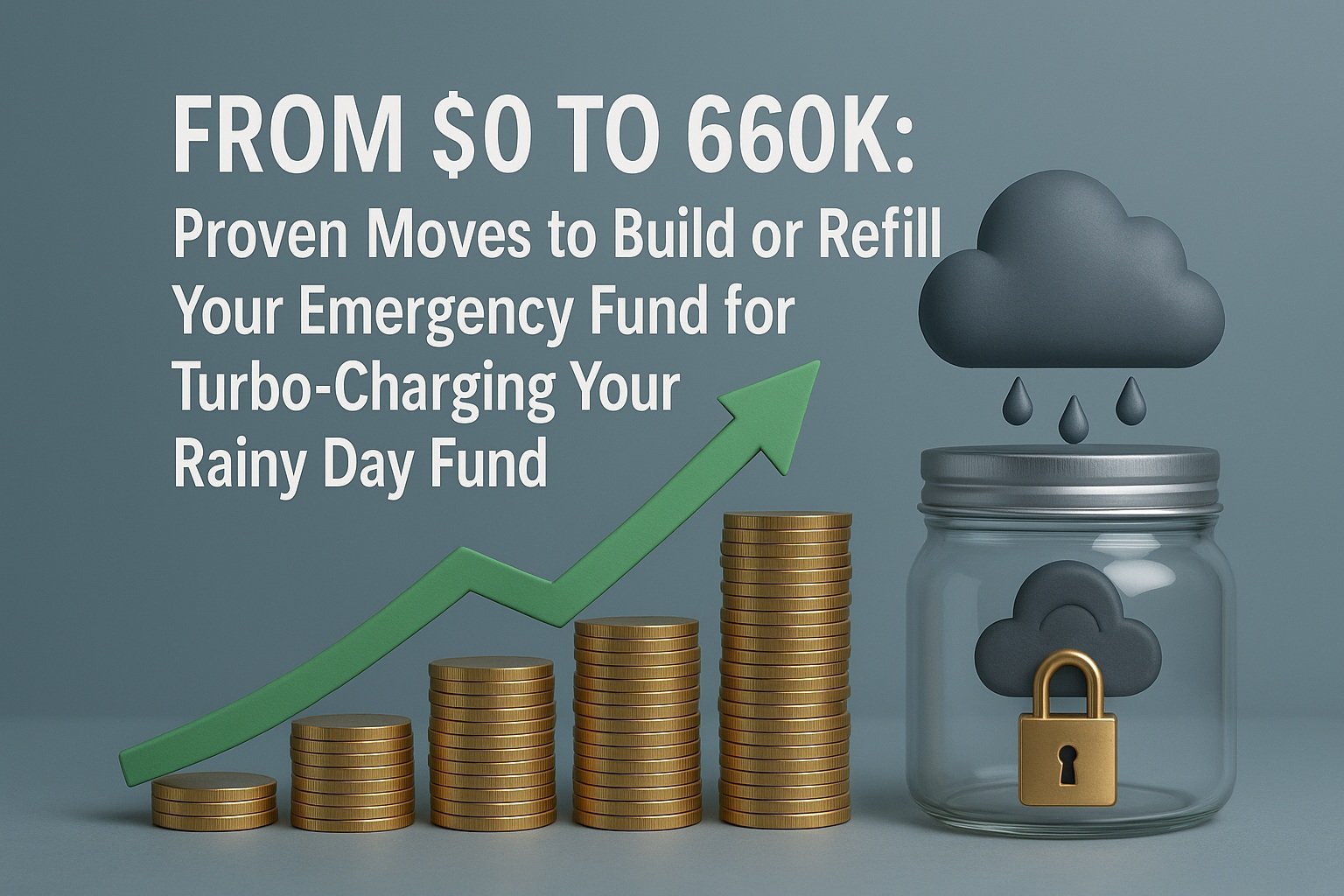
From $0 to $60K: Proven Moves to Build or Refill Your Emergency Fund for Turbo-Charging Your Rainy Day Fund
An emergency fund is a liquid cash reserve that covers three to twelve months of essential expenses. Think of it as a financial cushion ready to catch you when life pushes you off balance. In 2025, that cushion is more important than at any time in recent memory. Rising inflation, quick-moving technological change, climate-related disasters and volatile interest rates now collide to create an environment where sudden bills or job interruptions can snowball fast.
A recent survey shows 73 percent of adults say higher prices have made saving harder. Layoffs in tech and media are taking longer to bounce back from, while medical deductibles keep climbing. If you have ever wondered whether your rainy day fund is big enough or if you still need one when credit cards feel convenient, you are in the right place. This guide explains exactly why emergency funds matter more than ever in 2025, how much to set aside for your unique situation, where to park the cash for maximum safety and yield, and the exact week-by-week moves that will get you there faster. By the end, you will know the smartest way to build or refill your emergency savings without sacrificing every comfort you enjoy today.
(Primary keyword appearances so far: emergency fund/emergency funds = 4; keep count as you read.)
What Is an Emergency Fund & Why It Matters in 2025
Quick Definition & Purpose
At its core, an emergency fund is money you can reach within 24 hours without fees or market risk. That money serves one job only: covering unexpected expenses or income gaps. Car transmission fails? Job contract ends suddenly? Hospital co-pay surprises you? The fund pays. Because it is liquid, you do not have to sell stock at a loss, break a certificate of deposit early, or rely on high-interest credit cards when time is tight.
2025 Risk Landscape
The classic advice of three to six months of costs came from an era with lower inflation and shorter job hunts. Today, real wages lag behind price growth. At the same time, AI-driven automation is reshaping entire roles in months instead of decades, so even well-paid knowledge jobs feel less secure. Climate events bring larger deductibles and wider insurance gaps. A single storm-damaged roof or flooded basement can eat a half-year salary. Health care premiums and deductibles keep climbing too. In short, the risks we face in 2025 are bigger, costlier and less predictable than a decade ago.
Key Stat Call-out
Financial planners watching household budgets estimate that a comfortable six-month reserve for the median U.S. household now rings in near 35,000 USD. Families with higher housing costs or variable freelance income may need nine to twelve months. That is a daunting sum, yet achievable with the right plan.
How Much Should You Save? 2025 Benchmarks
Classic 3-6 Months vs New 6-12 Months Guidance
The old three-month guideline worked when:
Job searches averaged four to six weeks
Inflation hovered at two percent
Interest rates let you borrow cheaply in a pinch
None of those remains true. A typical job search in white-collar fields now stretches three to five months. Inflation around four percent chips away at purchasing power, and credit card rates over twenty-three percent make borrowing a last resort. For many, a six- to twelve-month emergency fund is the new sweet spot. Use the higher end if you have:
Commission-based or seasonal income
One household earner
High-deductible health insurance
A large mortgage or rent obligation
Translating Into Dollars (Starter, Core, Stretch Goals)
| Goal Level | Months of Expenses | Dollar Target (example household) | One-Sentence Caption |
|---|---|---|---|
| Starter | 1-2 | 5 000 | A basic buffer keeps small shocks off the credit card. |
| Core | 3-6 | 15 000-30 000 | Covers typical layoffs, short disability leaves or repairs. |
| Stretch | 6-12 | 30 000-60 000 | Guards against long job hunts or major medical bills. |
Adjust the numbers to your own monthly bills. Multiply your bare-bones budget (housing, food, utilities, insurance, minimum loan payments) by your chosen months. That total is your emergency fund’s destination.
DIY Calculator Pointer
If spreadsheets feel tedious, use a quick online savings calculator. Enter monthly expenses, months to cover and current savings. The tool will show you the gap and how much to autosave weekly. Watching the timeline shrink provides built-in motivation.
Five Reasons Emergency Funds Are Critical Right Now
1. Inflation Eats Purchasing Power
Price levels rose fast in 2023 and 2024. While the pace cooled, many goods remained twenty percent more expensive than three years ago. An emergency fund prevents you from relying on credit cards just to keep groceries on the table when costs spike. By holding cash in a high-yield account that pays over four percent, you keep pace with some of the price creep.
2. Automation Extends Unemployment Durations
AI tools can replace or streamline roles at every pay grade. When layoffs hit, rehiring can take longer because fewer positions open at the same salary. A larger cash buffer lets you search thoughtfully instead of accepting the first low offer. That means better job security once you land a new role.
3. High Interest Rates Punish Borrowers
The average credit card annual percentage rate (APR) is now above twenty-three percent. Compare that to the four percent yield on a high-yield savings account. Borrowing to cover emergencies locks you into payments that rise if variable rates adjust. Holding your own reserve keeps you out of that trap.
4. Climate-Related Disasters Are Costlier
Storms, wildfires and floods strike people far outside traditional danger zones. Even with insurance, deductibles for property damage can start at two percent of a home’s value. If your roof replacement costs 18 000 USD and you owe the first 5 000, you will be glad those dollars are ready.
5. Medical Bills Remain the Top Bankruptcy Trigger
High-deductible plans often leave families paying the first 7,500 USD or more of care. A cash reserve stops a broken bone from breaking the bank. It also covers time off work during recovery.
Step-by-Step Plan to Build or Refill Your 2025 Emergency Fund

Audit & Trim Discretionary Spending (Week 1)
Start with a one-hour calendar block. Pull the last three months of statements. Highlight every non-essential line item: streaming services, impulse restaurants, and brand-name extras. Add them up. Most households find 300-600 USD per month they can reroute. Cancel, pause or downgrade the obvious items first. Remember, this is temporary; once your emergency fund reaches a core level, you can add back the luxuries you truly enjoy.
Choose a High-Yield Savings Home (> 4 percent APY)
Parking cash under a low-interest checking account is like leaving groceries in the sun. In 2025 many online banks offer four to four-point-three-five percent APY and allow up to five withdrawals monthly. Pick an account that is FDIC or NCUA insured, has zero monthly fees, and lets you nickname the account “Emergency Funds” for mental clarity. Some providers even allow creating multiple buckets inside one login, perfect for labelling a rainy day fund versus a vacation fund.
Automate Weekly Transfers (Weeks 2-12)
Automation removes willpower from the equation. Decide on a dollar figure you will not miss – maybe fifty or seventy-five dollars – and set a weekly transfer from checking to the new high-yield savings. Weekly schedules build momentum faster than monthly and make the process feel painless. Increase the amount by ten percent every quarter until you hit your target.
Boost Income: Gig Work, Tax Refunds, Selling Idle Items
Cutting expenses has limits, but income potential is wide. Consider freelancing a skill, driving rideshare for weekend hours or selling unused tech on marketplace sites. Direct every extra dollar straight to the emergency funds account before it reaches regular checking. A three-thousand-dollar tax refund dropped in March could shave four months off your savings calendar.
Quarterly Inflation Check-Up & Adjust Target
Set a calendar reminder every three months. Review your necessary expenses – rent, insurance, groceries. If they rose by more than two percent, adjust your emergency fund goal. Adding another five hundred dollars now is easier than catching up later when a crisis hits.
Where to Keep Your Emergency Cash in 2025
High-Yield Online Savings Accounts (FDIC/NCUA-insured, 4 percent – 4.35 percent APY)
These accounts strike the balance between safety, liquidity and yield. Interest compounds daily, crediting monthly. Funds transfer to your main bank in one to two business days. Some platforms issue ATM cards for true emergencies, though avoid routine swiping to keep discipline.
Money-Market Accounts for Debit-Card Access
Money market accounts combine savings account insurance with the check-writing or debit access of a checking account. Yields track closely with online savings. Use this option if you must have immediate in-store access during a natural disaster evacuation, for example.
3-Month T-Bills or Short-Term Bond ETFs (pros/cons)
Treasury bills maturing in thirteen weeks pay yields comparable to savings accounts. They add a government guarantee but introduce settlement delays. Selling a bond exchange-traded fund can take two days. For the core part of your emergency fund, simple savings is still best. A small slice in T-Bills can slightly boost returns on the portion you will not need for fast cash.
What to Avoid
Cryptocurrency or volatile stocks – price swings can wipe out value right when you need it.
Long-term certificates of deposit – early withdrawal penalties eat months of yield.
Prepaid gift cards – easy to misplace and sometimes carry inactivity fees.
Common Pitfalls to Avoid
Using credit cards as the entire fallback – credit limits shrink in recessions and interest rates spike on missed payments.
Under-funding during low inflation – when prices are calm, it is tempting to dip into the stash. Keep discipline.
Over-funding while carrying high-interest debt – if your card charges twenty-five percent, pay it down after your starter emergency fund is set.
Keeping the fund in the same account as spending money – separation builds psychological walls.
Forgetting to replenish after a withdrawal – every use should kick off a new savings sprint until the fund is whole again.
FAQs
| Question | Quick Answer (snippet-ready) |
|---|---|
| How big should an emergency fund be in 2025? | Aim for 6-12 months of essential expenses: about 35,000 USD for the median household. |
| Should I pay off debt or build an emergency fund first? | Build a 1 000-2 000 USD starter fund, then attack high-interest debt while topping up savings in parallel. |
| Where should I keep my emergency fund money now that rates are high? | In an FDIC-insured high-yield savings or money market account paying at least 4 percent APY. |
| How often should I review my emergency fund size? | Every six months or after major life changes like a new job, baby or move. |
| Is a HELOC or personal loan a substitute for an emergency fund? | No. Credit adds repayment risk and can disappear during downturns. |
Related post

Budgeting Tips for Single Moms



